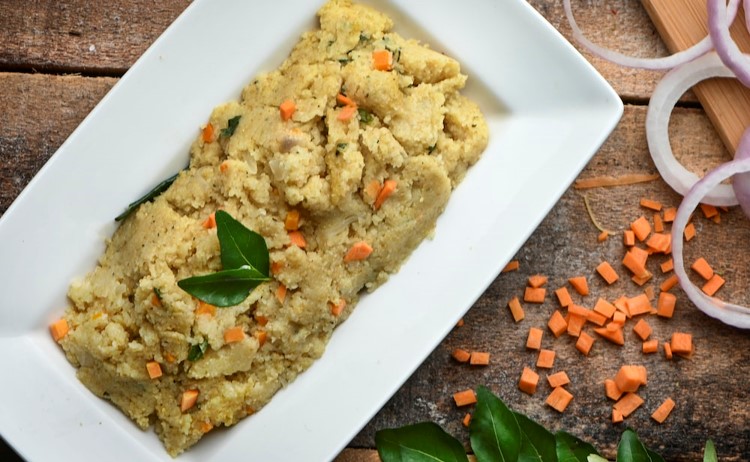Understanding Semolina
What is Semolina: From Its Origin to Its Uses
Semolina is a type of flour that is made from hard durum wheat, which is a type of wheat that is high in protein and gluten. It is commonly used in the Mediterranean, Middle Eastern, and Indian cuisines. Semolina has several regional names such as sooji in India, suji in Pakistan and Bangladesh, semoule in French, and semola in Italian. The name semolina comes from the Italian word semola, which means bran.
Semolina is a healthy and nutritious ingredient that is widely used in many cuisines around the world. It is a rich source of carbohydrates, protein, vitamins, and minerals, and is low in fat. Semolina can be used in several ways in cooking, making it a versatile ingredient in the kitchen. Whether you are making pasta, bread, or a dessert, semolina is a great ingredient to use that adds a nutty and rich flavor to any dish.
How Is Semolina Made?
Semolina is made by grinding hard durum wheat into a coarse flour. The wheat is first cleaned and then tempered with water. This process allows the wheat to absorb water and makes it easier to grind. The wheat is then passed through a series of rollers to produce the coarse flour known as semolina.
Types of Semolina
Semolina is a coarse flour that is made from durum wheat. It is a versatile ingredient that is used in many cuisines around the world, from Italian pasta to Indian desserts. Semolina is available in several different types, each with its own unique properties and uses. In this article, we will explore the various types of semolina and their characteristics.
Fine Semolina
Fine semolina is the most commonly available type of semolina. It has a fine, sandy texture and is pale yellow in color. Fine semolina is often used in Italian pasta making, as well as in Middle Eastern and Indian desserts. It is also used to make couscous, which is a staple in North African and Middle Eastern cuisine.
Coarse Semolina
Coarse semolina is similar to fine semolina, but it has a slightly larger grain size. It is commonly used in the production of bread, where it is used to give the bread a slightly nutty flavor and a chewy texture. It is also used in some Middle Eastern and Indian sweets, where its grainy texture adds a unique mouthfeel to the dish.
Instant Semolina
Instant semolina is a pre-cooked form of semolina that has been partially cooked and then dried. It is often used as a quick-cooking alternative to traditional semolina, as it can be prepared in a matter of minutes. Instant semolina is commonly used in the production of instant noodles, as well as in some Middle Eastern and Indian desserts.
Buckwheat Semolina
Buckwheat semolina is made from ground buckwheat and has a coarse texture. It is commonly used in the production of soba noodles, a traditional Japanese dish that is made by boiling buckwheat semolina with water. Buckwheat semolina is also used in some Middle Eastern and Indian sweets, where it adds a unique flavor and texture to the dish.
Quinoa Semolina
Quinoa semolina is made from ground quinoa and has a fine texture. It is commonly used in the production of gluten-free pasta, as well as in some Middle Eastern and Indian sweets. Quinoa semolina is high in protein and fiber, making it a healthy alternative to traditional wheat-based semolina.
Durum Wheat Semolina
Durum wheat semolina is made from the hard durum wheat, which is high in protein and gluten. This type of semolina has a high water absorption capacity and is commonly used in the production of pasta, as well as in some bread and pizza dough recipes. It is also used in some Middle Eastern and Indian sweets.
Corn Semolina
Corn semolina is made from ground cornmeal and has a coarse texture. It is commonly used in the production of polenta, a traditional Italian dish that is made by boiling corn semolina with water or milk. Corn semolina is also used in some Middle Eastern and Indian sweets, where it adds a unique flavor and texture to the dish.
Rice Semolina
Rice semolina is made from ground rice and has a fine texture. It is commonly used in the production of rice pudding, a traditional dessert in many cultures around the world. Rice semolina is also used in some Middle Eastern and Indian sweets, where it adds a unique flavor and texture to the dish.
Nutritional Properties of Semolina
Semolina is a rich source of nutrients and is packed with several health benefits. Here are some of the nutritional properties of semolina:
- Carbohydrates: Semolina is primarily composed of carbohydrates, which provide energy to the body. It is a slow-digesting carbohydrate, which means it releases energy slowly and keeps you full for longer periods.
- Protein: Semolina is a good source of protein and contains all the essential amino acids required by the body.
- Vitamins: Semolina is a rich source of vitamins, especially Vitamin E and Vitamin B-complex. Vitamin E is an antioxidant that helps protect the body from free radical damage, while Vitamin B-complex helps in the metabolism of carbohydrates, proteins, and fats.
- Minerals: Semolina is a good source of minerals such as iron, phosphorus, and magnesium. Iron is essential for the production of hemoglobin in the blood, while phosphorus and magnesium are important for bone health.
- Fiber: Semolina contains a good amount of fiber, which helps in regulating digestion and keeping the digestive system healthy.
- Low in fat: Semolina is a low-fat food and is ideal for those who are trying to maintain a healthy weight.
- Gluten: Semolina is high in gluten, which is a protein that provides elasticity to dough and helps in making pasta, bread, and other baked goods.
How to choose Semolina
Semolina is an essential ingredient in many popular dishes such as pasta, couscous, and Indian sweets like halwa. But, with so many types of semolina available in the market, it can be challenging to choose the right one for your recipe. In this article, we will discuss the factors to consider when choosing semolina to ensure that you get the perfect texture and taste in your dishes.
Purpose of Semolina
The first thing to consider when choosing semolina is the purpose of your recipe. Semolina used for making pasta or couscous has a different texture requirement than the semolina used for Indian sweets. For pasta, you need fine-grain semolina that can be easily molded, while for sweets like halwa, you need coarser semolina that gives a grainy texture.
Grain Size
The size of the grain in semolina can have a significant impact on the texture of the final dish. Fine-grain semolina is perfect for making smooth and creamy dishes like puddings, while coarser semolina is ideal for dishes that require a grainy texture, such as halwa or upma.
Color
Semolina can vary in color from white to yellow, depending on the wheat used to make it. Durum wheat semolina is usually yellow in color, while semolina made from softer wheat is often white. The color of the semolina can affect the color of the final dish. For example, if you want a bright yellow color in your pasta, you should choose yellow semolina.
Brand
Choosing a reputable brand is essential when it comes to semolina. Established brands ensure consistent quality and texture of their semolina. Buying from a trusted brand can also give you peace of mind about the safety and hygiene of the product.
Freshness
Semolina, like other grains, can become rancid over time, affecting the flavor and aroma of the final dish. Therefore, it is essential to choose fresh semolina. Look for the manufacturing or expiry date on the package before making a purchase.
Gluten Content
If you are gluten intolerant, you should look for semolina made from non-gluten-containing grains, such as corn or rice. Durum wheat semolina is high in gluten, making it unsuitable for people with celiac disease or gluten sensitivity.
Packaging
The packaging of semolina can affect its shelf life and freshness. Semolina should be stored in an airtight container to prevent moisture from seeping in. If you are purchasing semolina in bulk, look for packaging that is sturdy and airtight to ensure that the semolina remains fresh for an extended period.
Choosing the right semolina is crucial to ensure that your dishes turn out perfect. Consider the purpose of your recipe, grain size, color, brand, freshness, gluten content, and packaging when choosing semolina. By paying attention to these factors, you can get the perfect texture and flavor in your dishes, making them a culinary delight.
How to Use Semolina in Cooking
Semolina is a versatile ingredient and can be used in several ways in cooking. It is commonly used to make pasta, couscous, and bread. In India, it is used to make desserts such as halwa and upma. Semolina can also be used as a coating for fish and meat, giving it a crispy texture when fried. It can also be used in baking cakes, cookies, and other desserts.
How to Store Semolina
Semolina has a relatively long shelf life if stored correctly. It should be kept in an airtight container in a cool and dry place away from direct sunlight. Exposure to moisture can cause semolina to clump together, making it difficult to use. To prevent this, you can add a few grains of rice to the container, which will absorb any excess moisture. Stored properly, semolina can last for up to six months.
Uses of Semolina in Various Cuisines
Semolina is a versatile ingredient that is used in a wide variety of dishes, from sweet to savory. Here are some of the most popular uses of semolina in various cuisines.
Indian Cuisine
Semolina is a common ingredient in Indian cuisine, where it is used to make a variety of savory and sweet dishes. Upma is a popular breakfast dish made from roasted semolina, vegetables, and spices. Rava dosa is a crispy, crepe-like dish made from semolina, rice flour, and spices.
Italian Cuisine
Semolina is a key ingredient in many Italian dishes, including pasta, gnocchi, and pizza dough. Semolina gives pasta its signature texture and chewiness, making it a favorite among pasta lovers. Gnocchi made with semolina has a firmer texture and holds its shape better than those made with potato.
Middle Eastern Cuisine
In Middle Eastern cuisine, semolina is used to make a variety of sweets, including halva and basbousa. Halva is a dense, sweet confection made from semolina, sugar, and butter or oil. Basbousa is a moist cake made from semolina, yogurt, and syrup.
North African Cuisine
In North African cuisine, semolina is used to make couscous, a staple dish made from steamed semolina grains. Couscous is often served with stews, meats, or vegetables and is a popular dish during Ramadan.
European Cuisine
Semolina is used in a variety of European desserts, including semolina pudding and semolina cake. Semolina pudding is a creamy dessert made from semolina, milk, sugar, and vanilla. Semolina cake is a moist and flavorful cake made from semolina, sugar, eggs, and butter.
Understanding Semolina – Key Semolina Dishes
Semolina is used in a wide variety of dishes, from sweet to savory. Here are some of the key dishes made from semolina.
Pasta
Semolina is the key ingredient in many types of pasta, including spaghetti, macaroni, and lasagna. Pasta made with semolina has a firmer texture and holds its shape better than pasta made with regular flour.
See Also: Know Your Pasta – Farfalle
Gnocchi
Gnocchi made with semolina has a firmer texture and holds its shape better than those made with potato. They are often served with tomato sauce or butter and sage.
See Also: What is Gnocchi
Upma
Upma is a popular breakfast dish in India made from roasted semolina, vegetables, and spices. It is a hearty and flavorful dish that is often served with chutney or yogurt.

Halva
Halva is a dense, sweet confection made from semolina, sugar, and butter or oil. It is a popular dessert in the Middle East and is often served with tea.
FAQs – Understanding Semolina
What is Semolina?
Semolina is a coarse flour that is made from durum wheat. It is commonly used in making pasta, bread, and dessert recipes.
Can Semolina be stored for long periods of time?
Yes, Semolina can be stored for long periods of time if kept in an airtight container in a cool and dry place.
Can Semolina be used for gluten-free diets?
No, Semolina is made from durum wheat which contains gluten. Therefore, it is not suitable for gluten-free diets.
How can Semolina be used in pasta making?
Semolina is a key ingredient in making traditional Italian pasta recipes. It is typically mixed with water to form a dough that is then cut into various pasta shapes.
What are some traditional dishes that use Semolina?
Semolina is used in a variety of dishes around the world, including the Middle Eastern dessert Halva, the Indian dessert Sooji Halwa, and the Italian dessert Semolina Cake.
Can Semolina be used in savory dishes?
Yes, Semolina can be used in savory dishes such as couscous and polenta. It can also be used as a coating for fried foods, like chicken or fish.
Is Semolina the same as cornmeal?
No, Semolina is made from durum wheat while cornmeal is made from corn. They have different textures and are used in different types of recipes.
———————————————————————————————————
Foodcazt (www.foodcazt.com) is a Food Magazine. We help you discover food. Benefit from our Recipes, Reviews, Food Guides & Articles. We uncover trends, especially for Indian and Asian Cuisines. Please follow us to learn more. Uncover recipes. Learn about trends. Unearth unique restaurants. Find what moves you. Discover what inspires others. We uncover trends, especially for Indian Cuisine and Asian Cuisine.
It would mean the world to us, if you follow, like or subscribe on: YouTube, Facebook, Twitter, Instagram.





